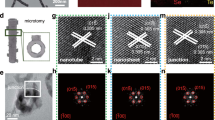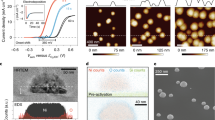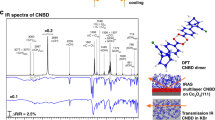Abstract
Artificial photosystems are advanced by the development of conformal catalytic materials that promote desired chemical transformations, while also maintaining stability and minimizing parasitic light absorption for integration on surfaces of semiconductor light absorbers. Here, we demonstrate that multifunctional, nanoscale catalysts that enable high-performance photoelectrochemical energy conversion can be engineered by plasma-enhanced atomic layer deposition. The collective properties of tailored Co3O4/Co(OH)2 thin films simultaneously provide high activity for water splitting, permit efficient interfacial charge transport from semiconductor substrates, and enhance durability of chemically sensitive interfaces. These films comprise compact and continuous nanocrystalline Co3O4 spinel that is impervious to phase transformation and impermeable to ions, thereby providing effective protection of the underlying substrate. Moreover, a secondary phase of structurally disordered and chemically labile Co(OH)2 is introduced to ensure a high concentration of catalytically active sites. Application of this coating to photovoltaic p+n-Si junctions yields best reported performance characteristics for crystalline Si photoanodes.
This is a preview of subscription content, access via your institution
Access options
Subscribe to this journal
Receive 12 print issues and online access
$259.00 per year
only $21.58 per issue
Buy this article
- Purchase on Springer Link
- Instant access to full article PDF
Prices may be subject to local taxes which are calculated during checkout





Similar content being viewed by others
References
Tachibana, Y., Vayssieres, L. & Durrant, J. R. Artificial photosynthesis for solar water-splitting. Nat. Photon. 6, 511–518 (2012).
Walter, M. G. et al. Solar water splitting cells. Chem. Rev. 110, 6446–6473 (2010).
Deng, X. & Tüysüz, H. Cobalt-oxide-based materials as water oxidation catalyst: recent progress and challenges. ACS Catal. 4, 3701–3714 (2014).
Friebel, D. et al. Identification of highly active Fe sites in (Ni, Fe)OOH for electrocatalytic water splitting. J. Am. Chem. Soc. 137, 1305–1313 (2015).
Zhang, M., de Respinis, M. & Frei, H. Time-resolved observations of water oxidation intermediates on a cobalt oxide nanoparticle catalyst. Nat. Chem. 6, 362–367 (2014).
Burke, M. S., Kast, M. G., Trotochaud, L., Smith, A. M. & Boettcher, S. W. Cobalt–iron (oxy)hydroxide oxygen evolution electrocatalysts: the role of structure and composition on activity, stability, and mechanism. J. Am. Chem. Soc. 137, 3638–3648 (2015).
Sanchez Casalongue, H. G. et al. In situ observation of surface species on iridium oxide nanoparticles during the oxygen evolution reaction. Angew. Chem. Int. Ed. 53, 7169–7172 (2014).
Kanan, M. W. et al. Structure and valency of a cobalt-phosphate water oxidation catalyst determined by in situ X-ray spectroscopy. J. Am. Chem. Soc. 132, 13692–13701 (2010).
Risch, M. et al. Water oxidation by amorphous cobalt-based oxides: in situ tracking of redox transitions and mode of catalysis. Energy Environ. Sci. 8, 661–674 (2015).
González-Flores, D. et al. Heterogeneous water oxidation: surface activity versus amorphization activation in cobalt phosphate catalysts. Angew. Chem. Int. Ed. 54, 2472–2476 (2015).
Bergmann, A. et al. Reversible amorphization and the catalytically active state of crystalline Co3O4 during oxygen evolution. Nat. Commun. 6, 8625 (2015).
Koza, J. A., He, Z., Miller, A. S. & Switzer, J. A. Electrodeposition of crystalline Co3O4—a catalyst for the oxygen evolution reaction. Chem. Mater. 24, 3567–3573 (2012).
Indra, A. et al. Unification of catalytic water oxidation and oxygen reduction reactions: amorphous beat crystalline cobalt iron oxides. J. Am. Chem. Soc. 136, 17530–17536 (2014).
Abdi, F. F. et al. Efficient solar water splitting by enhanced charge separation in a bismuth vanadate-silicon tandem photoelectrode. Nat. Commun. 4, 2195 (2013).
Sun, J., Zhong, D. K. & Gamelin, D. R. Composite photoanodes for photoelectrochemical solar water splitting. Energy Environ. Sci. 3, 1252–1261 (2010).
Riha, S. C. et al. Atomic layer deposition of a submonolayer catalyst for the enhanced photoelectrochemical performance of water oxidation with hematite. ACS Nano 7, 2396–2405 (2013).
Yang, J. H. et al. Efficient and sustained photoelectrochemical water oxidation by cobalt oxide/silicon photoanodes with nanotextured interfaces. J. Am. Chem. Soc. 136, 6191–6194 (2014).
Donders, M. E., Knoops, H. C. M., van, M. C. M., Kessels, W. M. M. & Notten, P. H. L. Remote plasma atomic layer deposition of Co3O4 thin films. J. Electrochem. Soc. 158, G92–G96 (2011).
George, S. M. Atomic layer deposition: an overview. Chem. Rev. 110, 111–131 (2010).
McCrory, C. C. L., Jung, S. H., Peters, J. C. & Jaramillo, T. F. Benchmarking heterogeneous electrocatalysts for the oxygen evolution reaction. J. Am. Chem. Soc. 135, 16977–16987 (2013).
McCrory, C. C. L. et al. Benchmarking hydrogen evolving reaction and oxygen evolving reaction electrocatalysts for solar water splitting devices. J. Am. Chem. Soc. 137, 4347–4357 (2015).
Strada, G. N. M. Ossidi ed idrossidi del cobalto. Gazzetta Chim. Ital. 58, 419–433 (1928).
Alloyeau, D., Freitag, B., Dag, S., Wang, L. W. & Kisielowski, C. Atomic-resolution three-dimensional imaging of germanium self-interstitials near a surface: aberration-corrected transmission electron microscopy. Phys. Rev. B 80, 014114 (2009).
Biesinger, M. C. et al. Resolving surface chemical states in XPS analysis of first row transition metals, oxides and hydroxides: Cr, Mn, Fe, Co and Ni. Appl. Surf. Sci. 257, 2717–2730 (2011).
Gerken, J. B. et al. Electrochemical water oxidation with cobalt-based electrocatalysts from pH 0–14: the thermodynamic basis for catalyst structure, stability, and activity. J. Am. Chem. Soc. 133, 14431–14442 (2011).
Yeo, B. S. & Bell, A. T. Enhanced activity of gold-supported cobalt oxide for the electrochemical evolution of oxygen. J. Am. Chem. Soc. 133, 5587–5593 (2011).
Trotochaud, L., Ranney, J. K., Williams, K. N. & Boettcher, S. W. Solution-cast metal oxide thin film electrocatalysts for oxygen evolution. J. Am. Chem. Soc. 134, 17253–17261 (2012).
Gerken, J. B. et al. Electrochemical water oxidation with cobalt-based electrocatalysts from pH 0–14: the thermodynamic basis for catalyst structure, stability, and activity. J. Am. Chem. Soc. 133, 12–14 (2011).
Plaisance, C. P. & van Santen, R. A. Structure sensitivity of the oxygen evolution reaction catalyzed by cobalt(II, III) oxide. J. Am. Chem. Soc. 137, 14660–14672 (2015).
Wang, H.-Y. et al. In operando identification of geometrical-site-dependent water oxidation activity of spinel Co3O4 . J. Am. Chem. Soc. 138, 36–39 (2016).
Kim, W., McClure, B. A., Edri, E. & Frei, H. Coupling carbon dioxide reduction with water oxidation in nanoscale photocatalytic assemblies. Chem. Soc. Rev. 45, 3221–3243 (2016).
Surendranath, Y., Kanan, M. W. & Nocera, D. G. Mechanistic studies of the oxygen evolution reaction by a cobalt-phosphate catalyst at neutral pH. J. Am. Chem. Soc. 132, 16501–16509 (2010).
Risch, M. et al. Water oxidation by amorphous cobalt-based oxides: in situ tracking of redox transitions and mode of catalysis. Energy Environ. Sci. 8, 661–674 (2015).
Koza, J. A., Hull, C. M., Liu, Y.-C. & Switzer, J. A. Deposition of β-Co(OH)2 films by electrochemical reduction of tris(ethylenediamine)cobalt(III) in alkaline solution. Chem. Mater. 25, 1922–1926 (2013).
Trotochaud, L., Mills, T. J. & Boettcher, S. W. An optocatalytic model for semiconductor–catalyst water-splitting photoelectrodes based on in situ optical measurements on operational catalysts. J. Phys. Chem. Lett. 4, 931–935 (2013).
Hill, J. C., Landers, A. T. & Switzer, J. A. An electrodeposited inhomogeneous metal-insulator-semiconductor junction for efficient photoelectrochemical water oxidation. Nat. Mater. 14, 1150–1155 (2015).
Scheuermann, A. G. et al. Design principles for maximizing photovoltage in metal-oxide-protected water-splitting photoanodes. Nat. Mater. 15, 99–105 (2016).
Chen, Y. W. et al. Atomic layer-deposited tunnel oxide stabilizes silicon photoanodes for water oxidation. Nat. Mater. 10, 539–544 (2011).
Chen, L. et al. p-type transparent conducting oxide/n-type semiconductor heterojunctions for efficient and stable solar water oxidation. J. Am. Chem. Soc. 137, 9595–9603 (2015).
Zhou, X. et al. 570 mV photovoltage, stabilized n-Si/CoOx heterojunction photoanodes fabricated using atomic layer deposition. Energy Environ. Sci. 9, 892–897 (2016).
Mei, B. et al. Protection of p+n-Si photoanodes by sputter-deposited Ir/IrOx thin films. J. Phys. Chem. Lett. 5, 1948–1952 (2014).
Hu, S. et al. Amorphous TiO2 coatings stabilize Si, GaAs, and GaP photoanodes for efficient water oxidation. Science 344, 1005–1009 (2014).
Sun, K. et al. Stable solar-driven oxidation of water by semiconducting photoanodes protected by transparent catalytic nickel oxide films. Proc. Natl Acad. Sci. USA 112, 3612–3617 (2015).
Kenney, M. J. et al. High-performance silicon photoanodes passivated with ultrathin nickel films for water oxidation. Science 342, 836–840 (2013).
Profijt, H. B., Potts, S. E., van de Sanden, M. C. M. & Kessels, W. M. M. Plasma-assisted atomic layer deposition: basics, opportunities, and challenges. J. Vacuum Sci. Technol. A 29, 050801 (2011).
Ravel, B. & Newville, M. ATHENA, ARTEMIS, HEPHAESTUS: data analysis for X-ray absorption spectroscopy using IFEFFIT. J. Synchrotron Radiat. 12, 537–541 (2005).
Kisielowski, C. et al. Real-time sub-Ångstrom imaging of reversible and irreversible conformations in rhodium catalysts and graphene. Phys. Rev. B 88, 024305 (2013).
Kisielowski, C. et al. Instrumental requirements for the detection of electron beam-induced object excitations at the single atom level in high-resolution transmission electron microscopy. Micron 68, 186–193 (2015).
Kisielowski, C. et al. Imaging columns of the light elements carbon, nitrogen and oxygen with sub Ångstrom resolution. Ultramicroscopy 89, 243–263 (2001).
Kisielowski, C. et al. Detection of single atoms and buried defects in three dimensions by aberration-corrected electron microscope with 0.5-Å information limit. Microsc. Microanal. 14, 469–477 (2008).
Acknowledgements
We thank H. Frei for valuable scientific discussions. This material is based upon work performed by the Joint Center for Artificial Photosynthesis, a DOE Energy Innovation Hub, supported through the Office of Science of the US Department of Energy under Award Number DE-SC0004993. PE-ALD and TEM were performed at the Molecular Foundry, supported by the US Department of Energy (DOE), Office of Basic Energy Sciences, Scientific User Facilities Division, under contract DE-AC02-05CH11231. XANES and EXAFS experiments were performed at the Stanford Synchrotron Radiation Lightsource (Beamline 7.3), operated under contract DE-AC02-05CH11231. Soft X-ray reflectivity and scattering experiments were performed at the Advanced Light Source (Beamline 11.0.1.2), under contract DE-AC02-05CH11231. L.H.H. acknowledges financial support from the Alexander von Humboldt Foundation.
Author information
Authors and Affiliations
Contributions
The manuscript was written through contributions of all authors. All authors have given approval to the final version of the manuscript.
Corresponding author
Ethics declarations
Competing interests
The authors declare no competing financial interests.
Supplementary information
Supplementary Information
Supplementary Information (PDF 1085 kb)
Supplementary Information
Supplementary movie 1 (MOV 201 kb)
Rights and permissions
About this article
Cite this article
Yang, J., Cooper, J., Toma, F. et al. A multifunctional biphasic water splitting catalyst tailored for integration with high-performance semiconductor photoanodes. Nature Mater 16, 335–341 (2017). https://doi.org/10.1038/nmat4794
Received:
Accepted:
Published:
Issue Date:
DOI: https://doi.org/10.1038/nmat4794
This article is cited by
-
Designing active oxides for a durable oxygen evolution reaction
Nature Synthesis (2023)
-
Designable heteronanocrystals via interface redox reaction
Nano Research (2023)
-
A n-Si/CoOx/Ni:CoOOH photoanode producing 600 mV photovoltage for efficient photoelectrochemical water splitting
Science China Materials (2022)
-
Functionalization of UiO-66-NH2 by In-Situ Incorporation of Nanomaterials to Enhance Photocatalytic Efficiency Towards Oxygen Evolution Reaction
Catalysis Letters (2022)
-
A self-healing catalyst for electrocatalytic and photoelectrochemical oxygen evolution in highly alkaline conditions
Nature Communications (2021)



